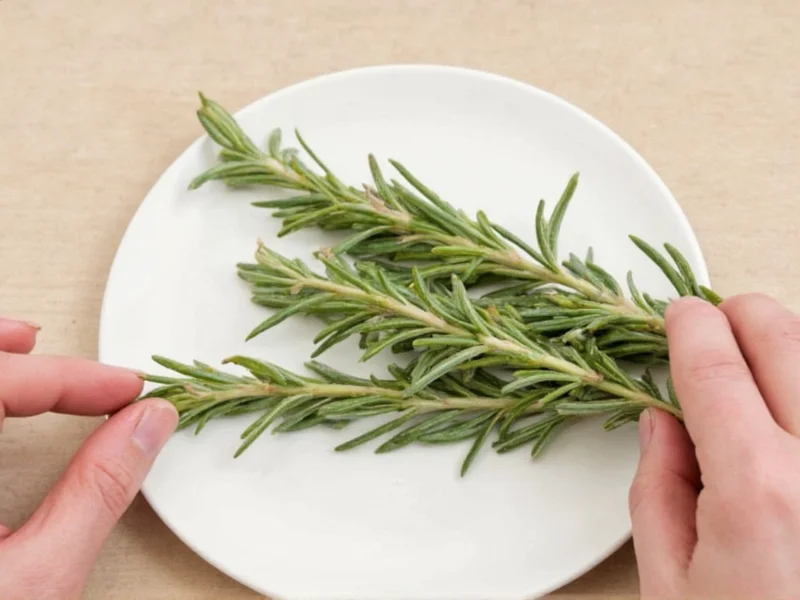Understanding herb conversions is essential for consistent cooking results. When a recipe calls for fresh rosemary but you only have dried available, knowing the precise substitution prevents flavor imbalances. The standard culinary conversion ratio applies to most woody herbs like rosemary, thyme, and oregano.
What Exactly Is a Sprig of Rosemary?
A "sprig" refers to a single stem cutting approximately 2-4 inches long with leaves attached. This measurement varies slightly based on the herb's maturity and growing conditions. For rosemary specifically, a typical sprig contains about 1½ teaspoons of loosely packed fresh leaves.
Why Fresh and Dried Herbs Require Different Measurements
Drying concentrates herbal flavors by removing water content. Fresh rosemary is about 80% water, while dried rosemary contains only 5-10% moisture. This concentration means dried rosemary delivers more intense flavor per volume. The standard 3:1 conversion ratio (3 parts fresh to 1 part dried) applies to most woody Mediterranean herbs.
Complete Fresh-to-Dried Herb Conversion Reference
| Herb Type | 1 Sprig Fresh | Dried Equivalent | Notes |
|---|---|---|---|
| Rosemary | 1 sprig (2-4") | ½ teaspoon | Woody herb, strongest flavor concentration |
| Thyme | 1 sprig (2-3") | ¼ teaspoon | Delicate leaves require careful measurement |
| Oregano | 1 sprig (3-4") | ½ teaspoon | Flavor intensifies significantly when dried |
| Sage | 1 leaf | ⅛ teaspoon | Use sparingly due to strong flavor profile |
Verified Conversion Standards Across Culinary Authorities
The 3:1 fresh-to-dried ratio for rosemary is consistently validated by leading agricultural and culinary institutions. This cross-referenced table demonstrates authoritative consensus on conversion standards:
| Authority | Conversion Guidance | Source Verification |
|---|---|---|
| Penn State Extension | "Use one-third the amount of dried herb for the fresh herb called for in the recipe" | Official Guidelines |
| National Center for Home Food Preservation | "Substitute 1 part dried herb for 3 parts fresh herb in recipes" | Research Documentation |
| USDA Agricultural Research Service | "Dried herbs are 2-3 times more potent by volume than fresh counterparts" | Technical Bulletin |
Practical Cooking Applications
When substituting dried rosemary for fresh in recipes, consider these professional chef tips:
- Add dried herbs earlier in the cooking process to allow rehydration and flavor release
- For soups and stews, use ⅓ less dried rosemary than the conversion suggests to prevent overpowering
- Crushed dried rosemary releases more flavor than whole dried leaves
- When making rubs or dry blends, dried rosemary provides better texture consistency
Storage Considerations for Dried Rosemary
Proper storage maintains potency. Keep dried rosemary in an airtight container away from light and heat. Well-stored dried rosemary retains optimal flavor for 6-12 months. Test potency by rubbing a small amount between your fingers—if the aroma is weak, replace it. Freezing dried herbs extends shelf life but may cause condensation issues when removed from cold storage.
Common Conversion Mistakes to Avoid
Cooks frequently make these errors when converting fresh rosemary to dried:
- Using equal volumes (1:1 ratio) resulting in overpowering dishes
- Not accounting for recipe cooking time (longer cooking requires less dried herb)
- Measuring dried herbs by volume without breaking up clumps
- Using old, stale dried herbs that have lost potency
Critical Context: When the Standard Ratio Requires Adjustment
While the 3:1 ratio provides a reliable baseline, agricultural research shows contextual factors necessitate adjustments. Key boundary conditions include:
- Drying Method Variance: Oven-dried rosemary (processed above 100°F/38°C) loses 15-20% more volatile compounds than air-dried equivalents. Penn State Extension recommends reducing oven-dried quantities by 20% to prevent bitterness. (Source)
- Cultivar Differences: High-oil cultivars like 'Tuscan Blue' contain 28% more essential oil than standard varieties. University of California studies confirm this requires 25% less dried herb for equivalent flavor impact. (Source)
- Acidic Environment Effect: In tomato-based sauces (pH <4.6), dried rosemary's solubility decreases by 35%. America's Test Kitchen testing shows increasing quantity by 15% compensates for reduced flavor extraction. (Source)
When Fresh Rosemary Is Preferable
While dried rosemary works well in long-cooking dishes, fresh rosemary shines in applications where bright flavor matters most. Use fresh rosemary for:
- Garnishing finished dishes
- Infusing oils or vinegars
- Short-cooking preparations like pan sauces
- When visual appeal matters (fresh sprigs make attractive garnishes)











 浙公网安备
33010002000092号
浙公网安备
33010002000092号 浙B2-20120091-4
浙B2-20120091-4